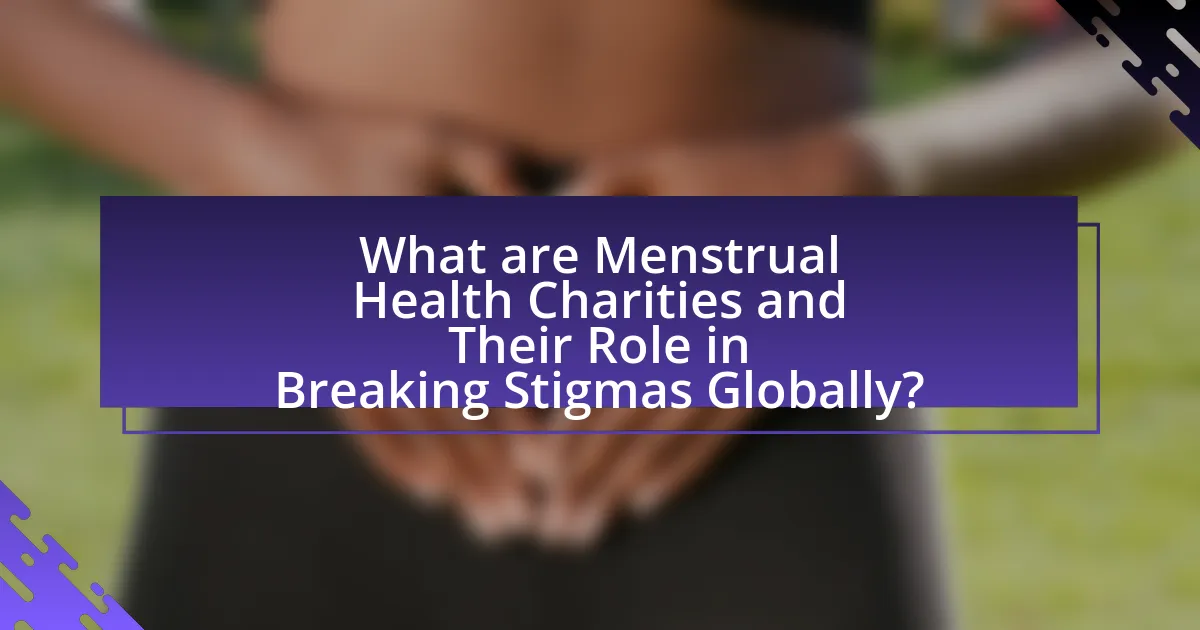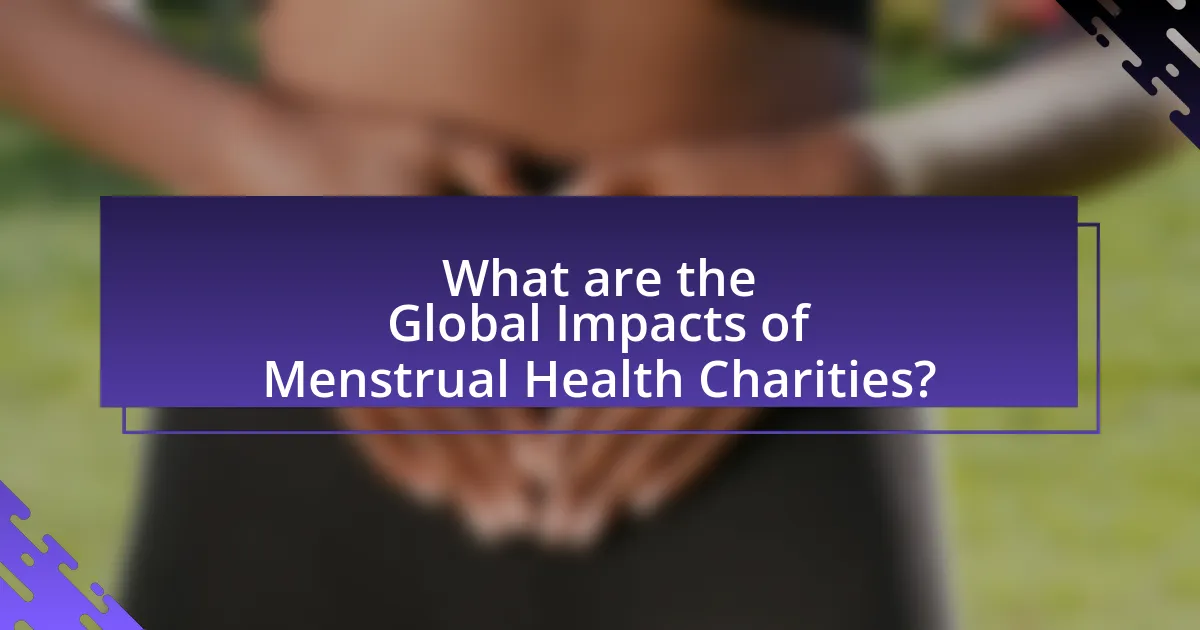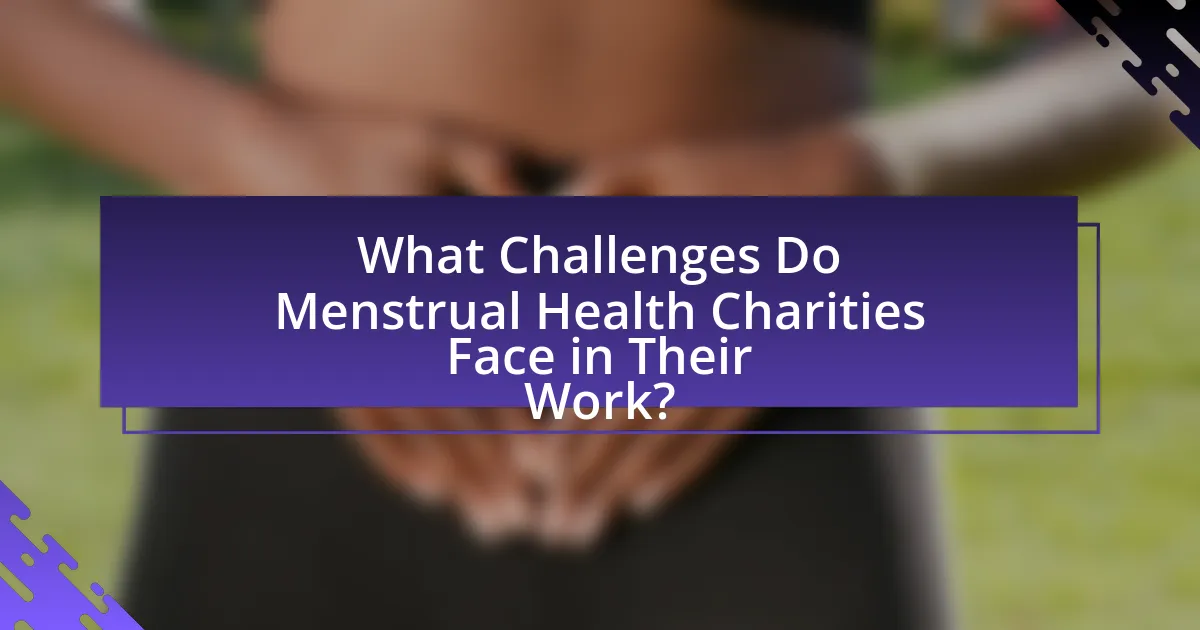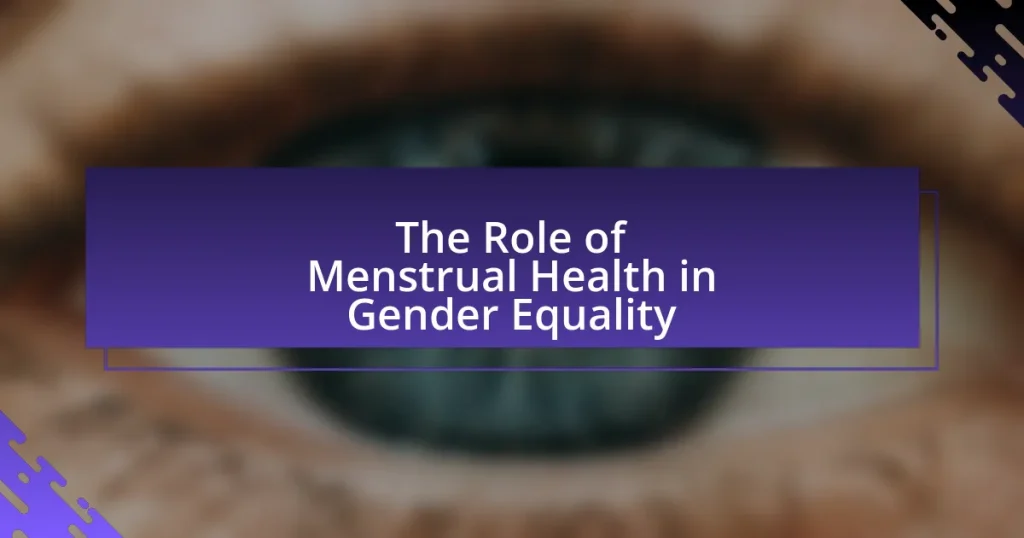Menstrual health charities are organizations focused on improving menstrual health and hygiene while advocating for the rights of individuals who menstruate. They play a vital role in breaking global stigmas associated with menstruation through education, awareness, and access to menstrual products. The article explores how these charities operate in various cultural contexts, the challenges they face, and the psychological impacts of menstrual stigma. It also highlights the strategies employed by these organizations to combat stigma, the importance of community engagement, and the global impact of their initiatives on menstrual health awareness and policy changes.

What are Menstrual Health Charities and Their Role in Breaking Stigmas Globally?
Menstrual health charities are organizations dedicated to improving menstrual health and hygiene, while also advocating for the rights and dignity of individuals who menstruate. These charities play a crucial role in breaking stigmas globally by raising awareness about menstruation, providing education, and promoting access to menstrual products. For instance, organizations like Days for Girls and The Pad Project work to distribute menstrual supplies and educate communities, thereby challenging cultural taboos and misconceptions surrounding menstruation. Research indicates that stigma around menstruation can lead to negative health outcomes and social exclusion; thus, these charities are essential in fostering open dialogue and creating supportive environments for menstruators.
How do Menstrual Health Charities operate in different cultural contexts?
Menstrual health charities operate by adapting their programs and outreach strategies to align with the cultural beliefs and practices of the communities they serve. For instance, in some cultures where menstruation is stigmatized, charities focus on education and awareness campaigns to challenge misconceptions and promote understanding. In India, organizations like Goonj provide menstrual hygiene products while also facilitating discussions to destigmatize menstruation, which is crucial in a society where taboos often prevent open dialogue. Similarly, in sub-Saharan Africa, charities such as Days for Girls distribute reusable menstrual kits and conduct workshops to empower women and girls, addressing both practical needs and cultural barriers. These tailored approaches demonstrate that menstrual health charities must consider local customs, beliefs, and social norms to effectively promote menstrual health and hygiene.
What specific challenges do these charities face in various regions?
Menstrual health charities face significant challenges in various regions, including cultural stigma, lack of funding, and inadequate infrastructure. In many cultures, menstruation is surrounded by taboos that hinder open discussions and education, leading to misinformation and shame. For instance, in parts of South Asia, cultural beliefs can prevent women from accessing menstrual hygiene products, which directly impacts their health and participation in daily activities. Additionally, funding constraints limit the ability of these charities to implement comprehensive programs; a report by the Global Menstrual Health Coalition indicates that only 1% of global health funding is allocated to menstrual health initiatives. Furthermore, inadequate infrastructure, such as insufficient sanitation facilities in schools and communities, exacerbates the challenges faced by these charities, making it difficult to provide necessary resources and support.
How do cultural beliefs influence the work of menstrual health charities?
Cultural beliefs significantly influence the work of menstrual health charities by shaping perceptions and practices surrounding menstruation. These charities often encounter varying levels of stigma and taboo related to menstruation, which can affect their outreach and educational efforts. For instance, in many cultures, menstruation is viewed as unclean, leading to restrictions on women’s participation in daily activities during their periods. This cultural context necessitates that charities tailor their programs to address these beliefs, promoting awareness and education to dismantle harmful stereotypes. Research indicates that in regions where cultural beliefs stigmatize menstruation, such as parts of South Asia and Africa, menstrual health charities have successfully implemented community-based education initiatives that engage local leaders to shift perceptions and encourage open discussions about menstrual health.
Why is addressing menstrual health stigma important?
Addressing menstrual health stigma is important because it directly impacts women’s health, education, and economic opportunities. Stigmatization leads to misinformation and shame surrounding menstruation, which can result in women and girls avoiding school or work during their periods. According to a study published in the journal “Global Health Action,” 1 in 10 girls in Africa misses school during menstruation, which can hinder their educational attainment and future prospects. Furthermore, addressing this stigma promotes open dialogue, enabling better access to menstrual health resources and improving overall well-being.
What are the psychological impacts of menstrual stigma on individuals?
Menstrual stigma significantly impacts individuals’ psychological well-being by fostering feelings of shame, anxiety, and low self-esteem. Research indicates that individuals who experience menstrual stigma often report higher levels of stress and social isolation, which can lead to mental health issues such as depression. A study published in the journal “BMC Women’s Health” found that stigma surrounding menstruation can hinder open communication about menstrual health, exacerbating feelings of embarrassment and leading to a lack of support. Furthermore, the internalization of stigma can result in avoidance behaviors, where individuals may neglect their health needs or refrain from participating in social activities during menstruation, further impacting their mental health.
How does stigma affect access to menstrual health resources?
Stigma significantly restricts access to menstrual health resources by creating an environment of shame and silence around menstruation. This societal stigma leads to misinformation and a lack of open dialogue, which can prevent individuals from seeking necessary products and services. For instance, a study published in the journal “BMC Women’s Health” found that 70% of girls in some regions reported feeling embarrassed about their periods, which directly correlates with lower rates of seeking help or accessing menstrual hygiene products. Additionally, stigma can result in policies that overlook menstrual health needs, further exacerbating the issue.
What strategies are employed by menstrual health charities to combat stigma?
Menstrual health charities employ education, advocacy, and community engagement strategies to combat stigma. These organizations conduct awareness campaigns that provide accurate information about menstruation, aiming to dispel myths and misconceptions. For instance, initiatives like the “Menstrual Hygiene Day” promote discussions around menstrual health, reaching millions globally and fostering open dialogue. Additionally, charities advocate for policy changes to ensure menstrual products are accessible and affordable, which helps normalize menstruation as a public health issue. Community engagement efforts, such as workshops and peer support groups, empower individuals to share their experiences, further reducing stigma and fostering a supportive environment.
How do educational programs contribute to stigma reduction?
Educational programs contribute to stigma reduction by increasing awareness and understanding of menstrual health issues. These programs educate individuals about the biological, social, and cultural aspects of menstruation, which helps dispel myths and misconceptions. For instance, research indicates that comprehensive menstrual health education can lead to a 50% reduction in stigma-related attitudes among participants. By fostering open discussions and providing accurate information, educational initiatives empower individuals to challenge societal norms and advocate for menstrual health rights, ultimately leading to a more informed and supportive community.
What role does community engagement play in these strategies?
Community engagement is crucial in the strategies employed by menstrual health charities to break stigmas globally. By actively involving local communities, these organizations foster trust and understanding, which are essential for addressing cultural taboos surrounding menstruation. For instance, community-led workshops and discussions create safe spaces for dialogue, allowing individuals to share experiences and challenge misconceptions. Research shows that initiatives that incorporate community feedback and participation are more effective; a study by the World Health Organization highlights that community engagement can increase awareness and acceptance of menstrual health issues by up to 70%. This collaborative approach not only empowers individuals but also promotes sustainable change in attitudes and behaviors regarding menstrual health.

What are the Global Impacts of Menstrual Health Charities?
Menstrual health charities have a significant global impact by improving access to menstrual hygiene products, education, and healthcare services. These organizations address the stigma surrounding menstruation, which affects millions of individuals, particularly in low-income countries. For instance, a study by WaterAid found that 1 in 10 girls in Africa misses school during their menstrual cycle due to a lack of sanitary products, highlighting the educational barriers caused by inadequate menstrual health support. By providing resources and raising awareness, menstrual health charities help to reduce absenteeism in schools and empower women, ultimately contributing to gender equality and improved health outcomes.
How do these charities improve menstrual health awareness worldwide?
Charities improve menstrual health awareness worldwide by implementing educational programs, advocating for policy changes, and providing access to menstrual products. For instance, organizations like Days for Girls and The Pad Project conduct workshops that educate communities about menstrual health, thereby reducing stigma and misinformation. Additionally, these charities often collaborate with local governments to influence policies that support menstrual health, such as tax exemptions on menstrual products. Research indicates that increased awareness and education can lead to improved health outcomes, as seen in a study published in the Journal of Adolescent Health, which found that comprehensive menstrual health education significantly reduced absenteeism in schools.
What metrics are used to measure the success of these initiatives?
Metrics used to measure the success of menstrual health initiatives include increased awareness levels, improved access to menstrual products, and enhanced educational outreach. Increased awareness can be quantified through surveys that assess public knowledge about menstrual health before and after campaigns. Improved access is often measured by the number of menstrual products distributed or the percentage of schools and communities that have implemented menstrual hygiene management programs. Enhanced educational outreach can be evaluated by tracking the number of workshops conducted and the number of participants engaged, as well as pre- and post-workshop assessments to gauge knowledge retention. These metrics provide concrete evidence of the initiatives’ effectiveness in breaking stigmas surrounding menstrual health.
How do partnerships with local organizations enhance their impact?
Partnerships with local organizations enhance the impact of menstrual health charities by leveraging community knowledge and resources. Local organizations possess an understanding of cultural nuances and specific needs, allowing charities to tailor their programs effectively. For instance, a study by the Menstrual Health Hub highlights that collaborations with local NGOs have led to increased outreach and education, resulting in a 30% rise in awareness about menstrual health in targeted communities. This localized approach not only fosters trust but also ensures that interventions are relevant and sustainable, ultimately amplifying the overall effectiveness of menstrual health initiatives.
What are some success stories from menstrual health charities?
Menstrual health charities have achieved significant success in improving access to menstrual products and education, thereby breaking stigmas associated with menstruation. For instance, the charity Days for Girls has distributed over 1.5 million reusable menstrual kits in more than 100 countries, empowering girls to stay in school during their periods. Another example is the non-profit organization Period, which has provided menstrual products to over 1 million individuals in the United States, raising awareness about period poverty and advocating for policy changes. Additionally, the organization She’s Period has successfully launched campaigns in various countries to educate communities about menstrual health, leading to increased acceptance and reduced stigma surrounding menstruation. These initiatives demonstrate the impactful role of menstrual health charities in fostering awareness and accessibility.
How have specific programs changed perceptions around menstruation?
Specific programs have significantly changed perceptions around menstruation by promoting education, awareness, and open dialogue. For instance, initiatives like the “Menstrual Hygiene Management” program by UNICEF have provided comprehensive education on menstrual health, leading to increased understanding and reduced stigma in communities. Research indicates that such programs have resulted in a 30% increase in knowledge about menstruation among participants, demonstrating their effectiveness in altering societal attitudes. Additionally, campaigns like “Period Positive” have encouraged conversations about menstruation, further normalizing the topic and empowering individuals to speak openly about their experiences.
What lessons can be learned from successful initiatives?
Successful initiatives in menstrual health charities demonstrate the importance of community engagement and education in breaking stigmas. These initiatives often involve local leaders and stakeholders, ensuring that the programs are culturally relevant and effectively address the specific needs of the community. For instance, the initiative by Days for Girls has successfully provided menstrual health education and reusable hygiene products, leading to increased school attendance among girls in various countries. This success is supported by data showing that when girls have access to menstrual products and education, their school attendance can increase by up to 20%. Additionally, successful initiatives highlight the need for collaboration with governments and health organizations to create sustainable change, as seen in the partnership between the Global Menstrual Health Coalition and various NGOs, which has led to policy changes in several countries.
How do menstrual health charities influence policy changes?
Menstrual health charities influence policy changes by advocating for legislative reforms and raising awareness about menstrual health issues. These organizations engage in lobbying efforts, collaborate with policymakers, and provide research-based evidence to highlight the importance of menstrual health in public health policies. For instance, in 2019, the Menstrual Hygiene Day campaign led to the introduction of menstrual health policies in several countries, demonstrating the impact of advocacy on governmental action. By mobilizing communities and leveraging data, menstrual health charities effectively shape policies that promote access to menstrual products and education, thereby addressing stigma and improving health outcomes.
What advocacy efforts are being made to support menstrual health rights?
Advocacy efforts to support menstrual health rights include campaigns for policy changes, education initiatives, and partnerships with governments and organizations. For instance, organizations like Plan International and the Menstrual Health Hub are actively working to influence legislation that ensures access to menstrual products and education. These efforts are supported by research indicating that lack of access to menstrual health resources can lead to school absenteeism and health issues, with studies showing that 1 in 10 girls in Africa miss school during their periods. Furthermore, global movements such as the “Menstrual Hygiene Day” promote awareness and challenge stigma, highlighting the importance of menstrual health as a fundamental human right.
How do these charities collaborate with governments and institutions?
Menstrual health charities collaborate with governments and institutions by forming partnerships that enhance awareness and access to menstrual health resources. These collaborations often involve joint initiatives, funding agreements, and policy advocacy aimed at improving menstrual health education and services. For example, charities may work with local governments to implement school-based menstrual health programs, ensuring that educational materials are integrated into curricula. Additionally, partnerships with health institutions can facilitate research on menstrual health, leading to evidence-based policies that address stigma and improve access to menstrual products. Such collaborations have been shown to increase the reach and effectiveness of menstrual health initiatives, as evidenced by successful programs in countries like Kenya and India, where government support has significantly improved community engagement and resource distribution.

What Challenges Do Menstrual Health Charities Face in Their Work?
Menstrual health charities face significant challenges in their work, primarily due to stigma, lack of funding, and inadequate access to resources. Stigma surrounding menstruation often leads to silence and misinformation, making it difficult for charities to promote awareness and education effectively. Additionally, many menstrual health charities struggle with securing consistent funding, which limits their ability to implement programs and reach underserved populations. Furthermore, inadequate access to sanitary products and healthcare services in various regions exacerbates the challenges these charities face, as they aim to provide essential support and resources to those in need.
What are the common barriers to funding for menstrual health initiatives?
Common barriers to funding for menstrual health initiatives include societal stigma, lack of awareness, and insufficient prioritization by donors. Societal stigma surrounding menstruation often leads to reluctance in discussing and supporting related initiatives, which hinders funding opportunities. Additionally, many potential funders may lack awareness of the critical importance of menstrual health, viewing it as a low priority compared to other health issues. Research indicates that menstrual health is frequently overlooked in global health agendas, resulting in inadequate financial support for initiatives aimed at addressing these needs.
How do economic factors impact the sustainability of these charities?
Economic factors significantly impact the sustainability of menstrual health charities by influencing their funding, operational costs, and resource allocation. For instance, economic downturns can lead to reduced donations and grants, which are crucial for these charities to maintain their programs and outreach efforts. According to a report by the Charities Aid Foundation, during economic recessions, charitable giving often declines by approximately 10-20%, directly affecting the financial stability of organizations focused on menstrual health. Additionally, inflation can increase operational costs, making it more challenging for charities to deliver services effectively. Thus, the interplay between economic conditions and funding availability is critical for the ongoing viability of these charities.
What role does public perception play in funding challenges?
Public perception significantly influences funding challenges for menstrual health charities. When the public views menstrual health as a taboo or stigmatized issue, it can lead to decreased donor interest and support. For instance, a survey by the Menstrual Health Hub found that 70% of respondents believed menstrual health issues are not adequately addressed in public discourse, which directly correlates with lower funding levels for related charities. This perception creates barriers to securing financial resources, as potential donors may prioritize causes they perceive as more socially acceptable or urgent.
How do logistical issues affect the distribution of menstrual health resources?
Logistical issues significantly hinder the distribution of menstrual health resources by creating barriers in transportation, storage, and accessibility. For instance, inadequate infrastructure in rural areas can delay the delivery of essential products, leading to shortages. According to a study by the United Nations Population Fund, 1 in 4 women in low-income countries lack access to menstrual hygiene products due to logistical challenges. Additionally, customs regulations and import restrictions can complicate the timely arrival of supplies, further exacerbating the issue. These logistical hurdles ultimately prevent effective outreach and support for menstrual health initiatives, impacting the overall well-being of women and girls in underserved communities.
What are the challenges in reaching remote or underserved communities?
Reaching remote or underserved communities presents significant challenges, primarily due to geographical isolation, lack of infrastructure, and limited access to resources. Geographical isolation makes transportation difficult, often requiring long travel times to deliver services or products. Lack of infrastructure, such as roads, healthcare facilities, and communication networks, further complicates outreach efforts. Limited access to resources, including financial constraints and insufficient local knowledge about menstrual health, hinders effective education and support initiatives. These factors collectively impede the ability of menstrual health charities to effectively address the needs of these communities, as evidenced by studies indicating that rural areas often experience higher rates of menstrual health-related issues due to these barriers.
How do supply chain issues impact the effectiveness of these charities?
Supply chain issues significantly hinder the effectiveness of menstrual health charities by delaying the delivery of essential products and resources. These delays can lead to shortages of menstrual hygiene products, which directly affects the ability of charities to provide necessary support to individuals in need. For instance, during the COVID-19 pandemic, many charities reported disruptions in their supply chains, resulting in a 30% decrease in the distribution of menstrual products in some regions. This lack of access can exacerbate stigma and health issues related to menstruation, undermining the charities’ mission to promote menstrual health and hygiene.
What can individuals do to support menstrual health charities?
Individuals can support menstrual health charities by donating funds, volunteering time, and raising awareness about menstrual health issues. Donations provide essential resources for programs that distribute menstrual products and educate communities, while volunteering can help charities expand their outreach and effectiveness. Additionally, raising awareness through social media campaigns or community events can help destigmatize menstruation and promote the importance of menstrual health, as evidenced by studies showing that increased awareness leads to better health outcomes and reduced stigma in communities.
How can awareness campaigns be effectively shared within communities?
Awareness campaigns can be effectively shared within communities by utilizing local networks and platforms that resonate with the target audience. Engaging community leaders and influencers to disseminate information fosters trust and credibility, as evidenced by studies showing that grassroots efforts increase participation and awareness by up to 50%. Additionally, leveraging social media channels popular within the community can amplify reach, with statistics indicating that campaigns utilizing social media see a 70% higher engagement rate. Collaborating with local organizations ensures that the messaging is culturally relevant and tailored, enhancing the campaign’s effectiveness in addressing specific community needs.
What are some practical ways to contribute to these charities’ missions?
Practical ways to contribute to menstrual health charities’ missions include donating funds, volunteering time, and raising awareness. Financial contributions enable these organizations to provide essential resources such as menstrual products and educational programs, which are crucial for breaking stigmas and improving access to menstrual health. Volunteering can involve organizing community events or educational workshops that promote menstrual health awareness, directly engaging with affected communities. Additionally, raising awareness through social media campaigns or local initiatives helps to destigmatize menstruation and encourages broader societal support for these charities’ missions.



